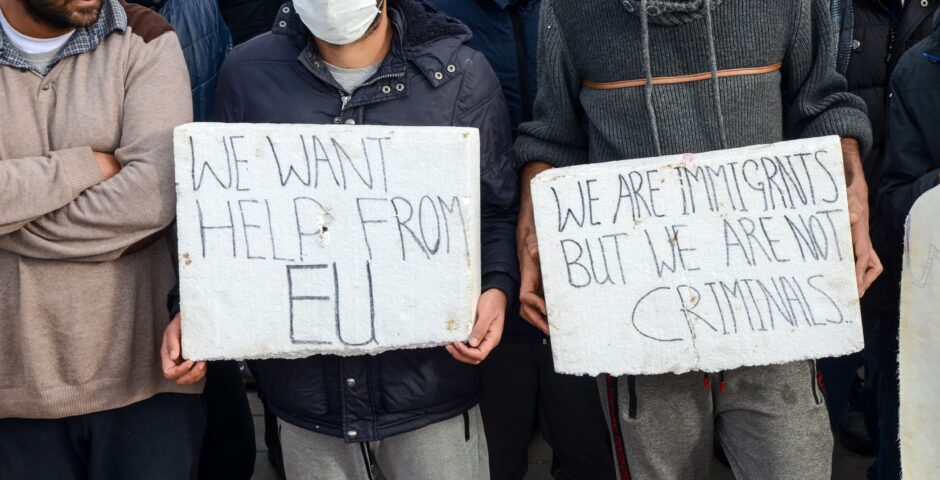‘The red flag has been raised’ but 1 in 10 cannot afford menstrual products

On menstrual leave, period poverty and breaking the taboo surrounding menstruation (Menstrual Hygiene Day – part 2).
On May 28, 2022, International Menstrual Hygiene Day, Shaping Europe’s first article in the series on menstruation was published. Welcome back to everyone who has already read the article! Did you miss the previous article? If so, just click here so you are completely up-to-date. The first article discussed the experiences of different women who menstruate, focusing on the different physical and mental menstrual symptoms. We also talked about the taboo surrounding menstruation and its consequences. In this article, we discuss three other issues surrounding menstruation, namely menstrual leave, period poverty, and the taboo around menstruation – issues that have been frequently in the European news in recent months.
Menstrual leave
In May 2022, the Spanish government announced that they are considering introducing a reform program that advocates, among other things, menstrual leave. The bill would mean that women and other people who menstruate* who experience severe menstrual pains and other related issues would have the option of three days of leave per month, paid for by the Spanish state.
Part of the program is also that menstrual products, such as tampons and sanitary pads, will be distributed free of charge in educational institutions, prisons, and social health care facilities. According to Irene Montero, the Spanish Minister of Equality, the new law will ensure that women no longer have to go to work in severe pain. It would also help to break the taboo surrounding menstruation. Initially, VAT on menstrual products would also be abolished, but this was not done because of the high costs.
The bill led to fierce discussions in Spain, but also abroad. In the Netherlands, it was discussed at the talk show tables, the proposal made it into the eight o’clock news and menstrual leave was the talk of the town for weeks. Proponents argue that menstrual leave helps break the stigma surrounding menstruation and ensures that more attention is paid to the unique aspects of women’s health, aspects that are now often ignored. Opponents, on the other hand, believe that the introduction of menstrual leave will cause the barrier for employers to hire women to be even higher than it is today. This argument assumes that attendance equals productivity. The question arises whether it would not be better to give women the right to stay at home if their menstrual symptoms prevent them from being productive at work. However, some fear that the new legislation will be abused.
Although Spain would be the first European country to introduce menstrual leave, there are already several countries worldwide where menstrual leave is part of the law, namely Taiwan, South Korea, Japan, Zambia, and Indonesia. In almost all of these countries, the legislation was introduced primarily because women working in industrial jobs did not have access to adequate sanitation. In Zambia, legislation was introduced to make the workplace more women-friendly.
A more detailed look at the laws of these countries shows that, despite the introduction of menstrual leave, there are still snags in the policy. For example, Japan was one of the first countries to enshrine menstrual leave into law in 1947. According to the law, women may request leave if they are hindered in their work during their periods. A Japanese survey found that many employers have policies around menstruation, including full leave and the ability to work from home. However, only a very small proportion of working women in Japan take advantage of menstrual leave, mainly because they are reluctant to openly state that they experience discomfort during their periods. In addition, it is not unlikely that this reluctance is related to the huge gender inequality in Japan. Globally, Japan ranks 117th in terms of economic participation and professional opportunities for women. This disadvantageous position likely makes using menstrual leave even more unattractive for many Japanese women.
The reluctance to request leave can also be seen in menstrual policies in the other countries mentioned above. Indonesia followed the Japanese example in 1948 by introducing menstrual leave. The law came under scrutiny in 1990 for being contradictory to women’s emancipation. Although South Korea introduced a law in 2001 that allows workers to receive one unpaid day of leave per month, the number of women taking advantage of it is rapidly declining. This may be partly explained by the attitudes of some male workers who view menstrual leave as a form of reverse sexism. For example, Sung Jae-gi, former leader of the group Men for Korea tweeted in 2012, “You women should be ashamed of yourselves! Why are you making such a fuss about menstruation when Korea has the lowest birth rate in the world?”
The question is whether a special menstrual leave is the solution since women also make little use of it in countries where such a policy has already been implemented. In the Netherlands, where there are already ample leave policies, many women indicate that they do not dare to admit that they occasionally take leave because of their periods, even if it is the reason. Many women are reluctant to take menstrual leave because it is often still taboo in the workplace. What seems to be needed to support women with severe symptoms during their periods is not so much a special menstrual leave, but social change in the way we look at women and their health. Although the examples mentioned above show that menstrual leave is not yet widely accepted, it can be an important step towards a society in which women do not have to feel ashamed when they have their periods and their complaints are taken seriously. Menstrual leave can ensure that there is more recognition of women’s complaints and it can show that it is normal not to work when they are in severe pain.
When we ask our respondents** about their opinions on menstrual leave, it is striking that most think it is a good idea. However, many women think that three days a month is too much. They indicated that they usually experience the worst symptoms for one or two days at the most, after which it subsides, so the number of days could be a lot lower. Emily thinks that it is difficult for employers if women drop out of work during their periods. Working from home, or a more generous policy regarding starting and ending times, could therefore also be a solution.
Dutch labour lawyer Maarten van Gelderen said in an interview with RTL News that he is not in favour of menstrual leave, because the Netherlands already has a generous sick leave policy. All persons with such symptoms that they are unable to work – whether they are flu symptoms, migraine symptoms, or menstrual symptoms – are entitled to leave, even if the symptoms occur regularly. In Spain, the idea is that women must first get a statement from a doctor about their menstrual issues. Only then can they be granted leave. Van Gelderen is positive about the fact that this is not the case in the Netherlands. Sick means sick, not well is not well; so you can just get time off. However, he misses the most important reason why menstrual leave should be introduced. Many women currently do not dare to request leave during their periods, in part because women are taught from an early age that pain during your period is normal and it is better to just push through. The introduction of menstrual leave, on the other hand, shows that menstrual complaints are taken seriously and breaks the idea that women are faking it when they have pain during their periods.
So while some in Europe are advocating for menstrual leave, others around the world are advocating its abolition. This involves forced menstrual leave, a still common human rights violation. Indeed, within some cultures or countries, girls and women are forced to stay at home or are placed outside the community on days when they have their periods. In Nepal and Afghanistan, 30% of menstruating girls do not attend school, in India, 20% of girls stop school altogether at the time of their first period because menstruation is still considered unclean in these countries. Major school delays or dropping out of school will make obtaining greater gender equality more difficult.
Period poverty
Another important issue surrounding menstruation is period poverty. This refers to financial, social, cultural, and political barriers that affect access to education, menstrual products, and access to health care. Simply put, period poverty exists when people do not have enough financial resources to buy menstrual products such as pads and tampons. With current inflation, the number of people who can no longer afford groceries – and therefore menstrual products – is increasing.
Limited access in many cases means that women must choose between buying menstrual products or food. In addition, a lack of menstrual products can prevent girls from attending school during their periods, resulting in negative consequences for their education. In addition, Plan International says that women who cannot afford pads or tampons often use toilet paper, old cloths, or newspapers. This increases the risk of health risks, such as infections. Some women also use the same pad or tampon for a too long period of time to economise. When using a tampon, in rare cases this can have serious consequences, such as getting Toxic Shock Syndrome, a rare disorder which can be lethal. Lastly, menstrual irregularity causes a decrease in mobility. Because women want to avoid leaking despite the lack of menstrual products, they sometimes decide to stay home from work or school. This has negative effects on the self-esteem and development of young girls and women.
Period poverty is a widespread problem in the European Union. It is estimated that 1 in 10 European women cannot afford menstrual products. Mind you, these figures are from before the current rising inflation. By now, the number may be even higher. Women menstruate between 350 and 480 times in their lives and menstruate for 3 to 7 days. All in all, women menstruate for 7 to 9 years, or about 10% of their lives, during which time they consume about 100 kg of menstrual products per person. Limited access to menstrual products thus has a huge impact on many women’s daily lives. And yet, even though about half of the EU’s inhabitants menstruate, the problem of period poverty is barely addressed both socially and politically.
Kenya was the first country in the world to offer free sanitary pads in schools in 2017. Three years later, in November 2020, the Scottish Parliament passed a law to ensure that menstrual products are offered for free in all public places, including schools, pharmacies, and community centres. Another approach to eliminating period poverty is a change in the VAT rates of menstrual products. No legislation in the European Union prescribes how much VAT may be levied on menstrual products, so rates vary widely. In the Netherlands, tampons and sanitary pads fall under the low VAT rate of 9%, but other countries, like Switzerland, Denmark and Croatia set the rate much higher, at 25%. The high prices make menstrual products a “luxury product,” when in fact they are much needed. So part of the solution to tackling period poverty could be found in a fixed low VAT rate on menstrual products.
Because governments are not taking too many measures to tackle period poverty, the number of (private) initiatives to combat the phenomenon has grown enormously in recent years. In more and more neighbourhoods cabinets appear from which people who need it can get, among other things, free menstrual products. This is something that is also a godsend for the unfortunately often forgotten group of homeless people. Krista Leussink from Wognum (Netherlands) has a “menstruation box” in her front yard. In an interview with the magazine LINDA, she explains that most women come by after dark to pick up the products. She also explains that products can be picked up at the health centre in Hoorn, or at the Salvation Army. For this, however, women must cross a threshold, a threshold that is not present with Leussink. She says: “I don’t look [and] don’t ask questions.”
In addition, menstrual products are increasingly available for free at various (public) facilities, at least in the Netherlands. Students and staff at Utrecht University have recently been able to get products from various counters if needed, the same goes for the Hogeschool van Amsterdam and Vrije Universiteit in Amsterdam. Hostel chain StayOkay also has menstrual products in the toilets, which guests can use free of charge. In addition, more and more secondary schools have lockers from which secondary school students can obtain menstrual products free of charge.
The respondents from our research come up with different solutions for period poverty. Municipalities can offer menstruation packages, or sanitary pads and tampons should be structurally present in the packages of the Food Bank, or the products should be reimbursed by the health insurance company. The respondents indicated that they see menstrual underwear or cups as a long-term solution to period poverty. These could be provided by the government. Although the cost is initially higher than a pack of pads or tampons, menstrual underwear, and cups last much longer – sometimes as long as 10 years! However, Neighbourhood Feminists, an Amsterdam-based organization dedicated to fighting period poverty, does not believe that menstrual underwear or cups are the holy grail. Even though tampons and pads are not sustainable, they are the most in demand. Neighbourhood Feminists believes it is important that women suffering from period poverty be allowed to decide for themselves which products to use; after all, it’s their body autonomy. Cups and menstrual underwear are also products that need to be cleaned properly. This is sometimes not feasible for undocumented people and the homeless, which in turn argues for disposable products.
Finally, respondent Emily indicated that, as far as she was concerned, period poverty was not just about menstrual products such as tampons or sanitary napkins, but also about medicines such as naproxen sodium, which is often recommended and used for severe menstrual pain. Naproxen sodium is available at all drugstores and costs – depending on the brand and the number of milligrams – 2.69 to 4.29 euros per pack, for 12 tablets. By comparison, paracetamol costs 0.59 cents for 20 pieces and 1.19 euros for 50 pieces at the same drugstore. However, the problem with paracetamol is that it often does not work effectively against menstrual pain. This is in contrast to NSAIDs such as naproxen sodium, which inhibit the production of the hormone prostaglandin, which causes menstrual pain. Given that one is usually allowed to take a maximum of three of these tablets per day, it takes about 4 days for the supply to run out already. So the cost of naproxen sodium tablets is certainly not low, especially since some women need a pack per period. Emily, therefore, advocates that painkillers also be offered in cabinets or packages.
Taboo
Merely emphasizing changes in the supply of menstrual products is not going to solve period poverty. Eliminating period poverty, in addition to improving access to menstrual products, also requires addressing the taboo and stigma surrounding menstruation. Indeed, part of period poverty is also access to accurate information. This is currently hampered by the fact that there is little talk of menstruation, and if we do talk about menstruation at all, it is often not talked about directly. In fact, a study found that there are over 5,000 synonyms for menstruation within languages worldwide. The synonyms range from “the red flag is hanging out” (Netherlands) and “shark week” (Puerto Rico) to “my things” (Italy) and “ses ragnagnas” (France). The latter is a mix of the words ragougnasses and gnagnagna (a French dialect) and refers to ‘the bad mood of women when they have their period’.
This shame of talking about menstruation has everything to do with the image that exists in many countries about menstruation. It is often associated with uncleanness and filth. From ancient times, some cultures have devised myths around menstruation. For example, there was a belief within many cultures that women’s cycles controlled the cycle of the moon. Later, many religious beliefs stated that women were unclean during their periods. Some Catholic movements see the discomfort of menstruation, like the pain of childbirth for that matter, as a punishment for Eve’s sin. In some countries, women are even discouraged from washing during their periods. This would contaminate the shared water sources. Menstruation was labelled “dirty” within the public health community. Vendors of menstrual products cleverly capitalized on this by labelling their packaging as “discreet”. After all, the idea of other people realizing you’re carrying a sanitary pad is, of course, horrifying.
Breaking the taboo around menstruation is unfortunately not something that can be done overnight. The previously published article revealed that the taboo among young children is still high. It is therefore important that something happens here; after all, the youth is the future. Fortunately, in recent years initiatives have been raining down to at least attempt to be part of the solution. There are all kinds of organizations that are committed to providing more knowledge on the subject, giving high school students – some of whom have never had proper information – guest lectures or even doing menstruation simulations together with (male) teachers or employers.
In addition, films are being made about menstruation and other hormonal changes, such as Pixar’s “Turning Red”. This film, in addition to receiving a lot of enthusiastic responses, also received a lot of criticism from parents who found the film ‘uncomfortable’. And then there are exhibitions, artworks, social media accounts, and YouTube videos like ‘the Menstruation Challenge’ in which the subject of ‘menstruation’ is not shunned. Talking about menstrual experiences, at least, seems to work well in creating understanding and knowledge. Menstrual Hygiene Day is therefore a great initiative to break the stigmas and also address period poverty. The organization wants menstruation to be “normal” by 2030. Whether that will happen is the question of course, but we in Europe are slowly moving in the right direction, that’s for sure.
*We are aware that not everyone who menstruates identifies as a woman and that not all women menstruate.
**Pseudonyms were used in this article. The real names of the respondents are known to the Dutch editors.
Sabine Herder is doing a master’s degree in Crisis and Security Management at Leiden University with a specialisation in Intelligence and National Security. Before this, she did a bachelor’s degree in Liberal Arts and Sciences with a major in International Relations.
Loes ter Horst is doing a master’s degree in Crisis and Security Management at Leiden University with a specialisation in Governance of Crisis. Last summer, she received a bachelor’s degree in Liberal Arts and Sciences (majoring in International Governance).
Anoek Zijderveld is a recently graduated student of International Relations specializing in Global Political Economy.
Image: Shutterstock




